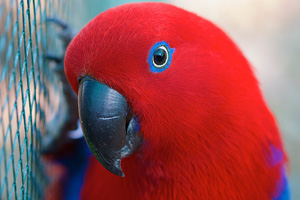
Avian Movie Critics
Parrot Haven is home to 26 spoilt Eclectus parrots, one Green Cheeked Conure and a very self opinionated African Grey. All have their very specific likes and dislikes but none more so than our matriarch Eclectus parrot, Red.
Red began life as a precocious baby and grew into an even more precocious mature hen. She is very set in her ways and isn’t afraid to voice her opinion. From favorite foods, preferred perching locations even to certain rock bands, Red knows what she likes. Red often likes to join us at night while watching a movie. It’s a routine she knows well, she perches on my chest, pulls one little foot up against her body and settles in for the nights entertainment. Movie night with Red is always fun but we must choose the movie carefully, if its not to Red’s liking we are severely reprimanded.
Action movies are amongst her favorite, and car chases excite her like nothing else. Her little eyes light up as she watches the vehicles tear down the road at breakneck speed and she squeals with joy when they crash in a fiery wreck. However car chases are often accompanied by gun fire and this does not sit well with our Red. She yells ‘naughty’, ‘no’ and ‘stop it’ as the bullets fly. According to Red, the actors are doing something wrong and she must give them a piece of her mind. As with any good action movie, someone is inevitably shot and Red will often pipe up and ask ‘you all right?’, just to make sure the person writhing in pain understands her concern. We tell her ‘yes Red, they are fine’ and she happily snuggles back down to enjoy the rest of the movie.
I sometimes wonder whether our parrots believe the television is a window into another world. They watch avidly, reacting to specific scenes as if they were watching reality play out. I remember watching a scary movie many years ago when Red decided to join us. She perched in her usual position however it wasn’t long before she grew agitated. The images on screen were clearly upsetting her and she moved closer to me seeking reassurance. I turned the movie off immediately and switched to a comedy and she visibly relaxed and returned to her normal self. We now save horror movies for day’s when Red is playing with her boyfriend in the aviary. I would hate to scare our gorgeous girl.
So next time you are watching T.V with your parrot, take note of their response. Some parrots simply zone out and pay little to no attention to the screen, others watch intently, loosing themselves in the world of make believe. If your Eckie is like our Red, then it won’t be long before you are choosing movies based on your parrots specific preferences. You certainly know you are an Eckie slave when your feathered friend dictates the movies you watch.


 I have seen my own work on other avian websites over the years, written word for word. On one such occasion I contacted the person and requested they remove the plagiarized content. I checked back later only to find my work re-worded however the author had made so many errors while changing my copy that the advice they were giving was harmful and potentially deadly. It made me shudder to think of people following such advice, especially at the detriment to their parrot.
I have seen my own work on other avian websites over the years, written word for word. On one such occasion I contacted the person and requested they remove the plagiarized content. I checked back later only to find my work re-worded however the author had made so many errors while changing my copy that the advice they were giving was harmful and potentially deadly. It made me shudder to think of people following such advice, especially at the detriment to their parrot.












